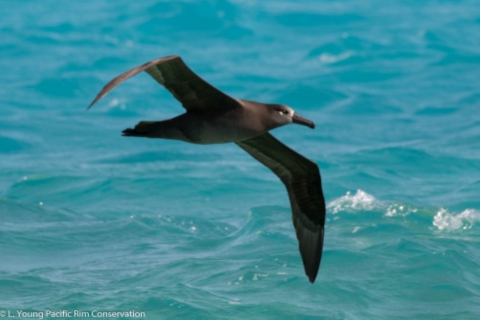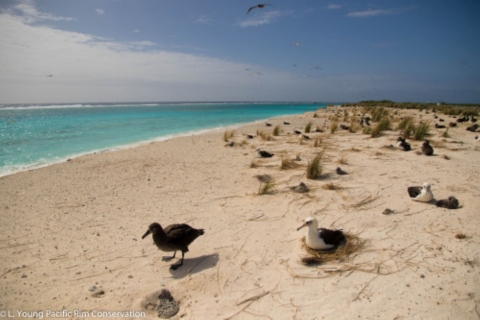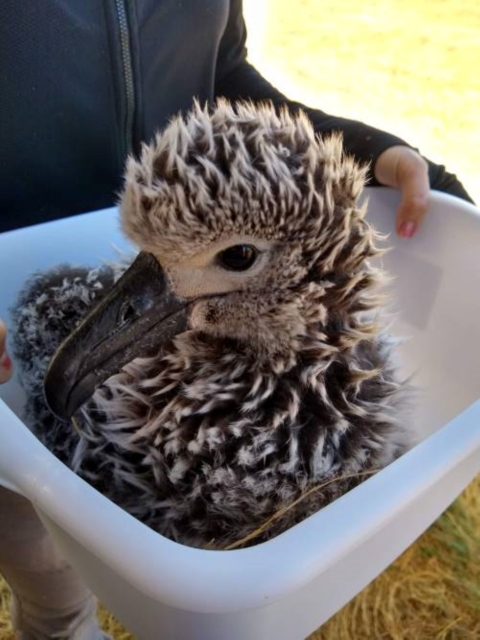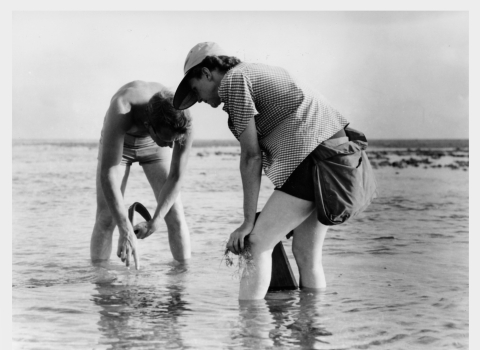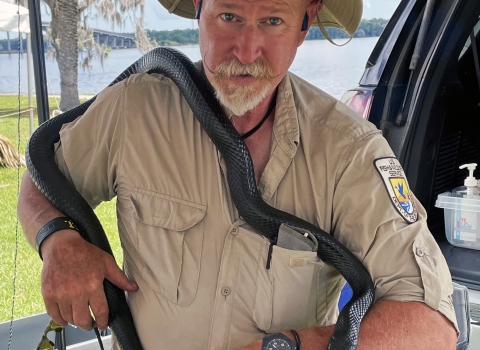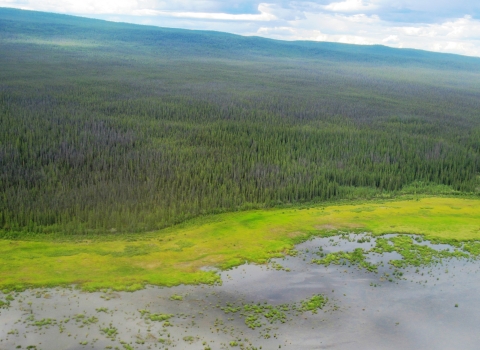This year is the 50th anniversary of the Endangered Species Act, a law that has been a powerful catalyst for conservation of America’s most treasured fish, wildlife, plants and their habitats. In the Pacific Region, our Tribes, state and federal agencies, and partners have joined with our dedicated staff to be the driving force behind the successes we share and the strength ensuring we can address the challenges ahead. Celebrate this milestone with us in this collection of stories as we reflect on past successes, assess current challenges, and envision an equally bright future for the next 50 years and beyond.
James Campbell National Wildlife Refuge has 25 new residents! On February 16, 2019, a group of kaʻupu (black-footed albatross) chicks made the 1,300 mile journey from Midway Atoll National Wildlife Refuge and Battle of Midway National Memorial in Papahānaumokuākea Marine National Monument to Oʻahu. Their new home is a 16 acre predator exclusion area inside James Campbell National Wildlife near Kahuku. These chicks are part of a long-term partnership effort to create new albatross colonies in the main Hawaiian islands that will be safe from predators, future sea-level rise, and to help perpetuate our relationships with these culturally significant bird species.
Culturally, kaʻupu and other albatross species are kinolau (body form) of the Hawaiian deity Lono. The birds’ return to land for mating coincides with the beginning of the makahiki season, occurring between October and November, and an important aspect to some practitioners’ ceremonies and practices during that time. Currently, ninety percent of the world’s kaʻupu population nests and breeds on Midway Atoll, Laysan Island, and Tern Island. All three of these locations have very low elevations and are predicted to be highly susceptible to storm surges and sea-level rise in the coming century. Kaʻupu are particularly at risk because they tend to nest along the shoreline where there is no protection from coastal vegetation.
“Midway Atoll is home to one of the largest black-footed albatross populations in the world. As conservation managers, it is important we use good science to evaluate other options that might protect these seabirds into the future,” said Midway Atoll Refuge and Memorial Project Leader Bob Peyton. “Refuges like Midway Atoll and James Campbell provide the healthy habitat that black-footed albatross, and other seabirds, needs to thrive.”
“We are thrilled that the Refuge can provide a safe place and a new home for this species on Oʻahu,” said Glenn Klingler, Refuge Manager, James Campbell National Wildlife Refuge. “This translocation is another step toward creating a new colony of albatross in the main Hawaiian Islands and ensuring the albatross will be protected for future generations.”
The chosen translocation site at James Campbell National Wildlife Refuge is high enough that they are less at risk from rising sea-levels and increasing storm surges. Additionally, birds nesting within the predator-free enclosure are protected from non-native predators that are prevalent in the main islands such as mongooses, rats, and feral cats and dogs.
The three-week-old chicks will be hand fed a diet of fish and squid and closely monitored by biologists for four to five months, until they are able to fly out to sea and feed themselves.
Kaʻupu chicks imprint on their birth colony at about one month of age and they will return to breed at the same colony as adults. By moving the chicks at this critical one-month period, they will imprint on their new home at the James Campbell National Wildlife Refuge and become the seeds of a new colony when they return as adults to raise their own chicks.
Between 2015 and 2018, Pacific Rim Conservation translocated 50 mōlī (Laysan albatross) chicks from Pacific Rim Missile Facility on Kauaʻi and 40 kaʻupu chicks from the Monument to the predator exclusion area of James Campbell, and eighty-two of those birds successfully fledged - took flight as adults. Once they fledge, juvenile albatross stay away at sea for 3 - 5 years before returning
home to find a mate and begin breeding. In 2018, the first James Campbell fledgling - a mōlī named V106 - returned to the colony.
“We are very hopeful that this colony will continue to grow provide a safe and stable home for albatross on Oʻahu,” said Klingler.
Partners on these projects include Pacific Rim Conservation, Papahānaumokuākea Marine National Monument, U.S. Fish and Wildlife Service, Department of Defense, the National Fish and Wildlife Foundation, and the David and Lucile Packard Foundation.
For photos of the translocation visit:
https://www.flickr.com/photos/usfwspacific/albums/72157667990450138
###
The U.S. Fish and Wildlife Service works with others to conserve, protect, and enhance fish, wildlife, plants, and their habitats for the continuing benefit of the American people. For more information, visit www.fws.gov/pacificislands, or connect with us through any of these social media channels at https://www.facebook.com/PacificIslandsFWS, www.flickr.com/photos/usfwspacific/, https://medium.com/usfwspacificislands or www.twitter.com/USFWSPacific
More about Pacific Rim Conservation: Our mission is to maintain and restore native bird diversity, populations, and ecosystems in Hawaiʻi and the Pacific Region. Pacific Rim Conservation was founded in 2006 as we saw a need for research-based management on native species, particularly birds, throughout Hawaiʻi and the Pacific. Island species, particularly those in Hawaiʻi, are some of
the most imperiled on earth and with so few individuals of some species, research was sorely needed to inform management actions. For nine years we filled that niche operating as a small business and in June 2015, we converted from a business to a 501©3 non-profit organization in order to better reflect our goals and to ensure that as much of our funding as possible was used to achieve our conservation projects.
Papahānaumokuākea is cooperatively managed to ensure ecological integrity and achieve strong, long-term protection and perpetuation of Northwestern Hawaiian Island ecosystems, Native Hawaiian culture, and heritage resources for current and future generations. Four co-trustees - the
Department of Commerce, Department of the Interior, State of Hawai‘i and the Office of Hawaiian Affairs - protect this special place. Papahānaumokuākea Marine National Monument was inscribed as the first mixed (natural and cultural) UNESCO World Heritage Site in the United States in July 2010. For more information, please visit www.papahanaumokuakea.gov.

